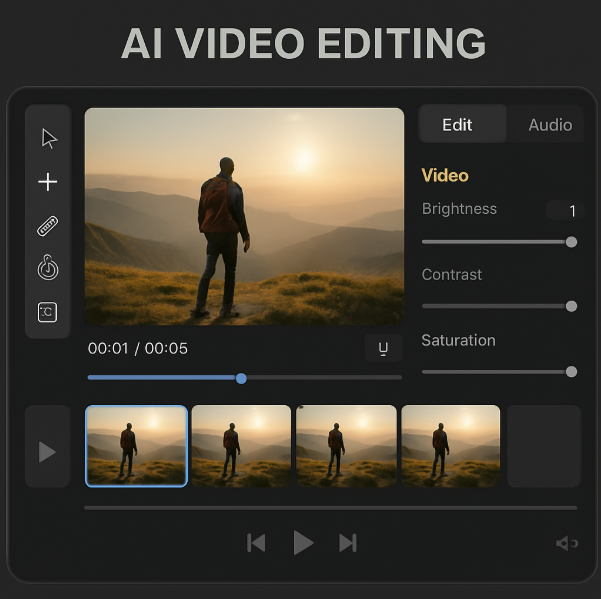In today’s fast-paced digital landscape, staying ahead of the curve is more crucial than ever for businesses aiming to maintain a competitive edge. The rise of Artificial Intelligence (AI) in various sectors has opened up new avenues for innovation, particularly in content creation. AI video editors, in particular, are transforming how businesses produce and manage video content. These tools are not only changing the way videos are edited but are also setting new standards for creativity, efficiency, and accessibility in the industry. In this article, we will explore how AI video editors are revolutionizing content creation, highlighting their benefits, limitations, and potential impact on various industries.
AI video editors are advanced software tools that leverage machine learning algorithms to automate and enhance the video editing process. These tools analyze vast amounts of data to understand video patterns and apply learned techniques to create polished content with minimal manual input. Unlike traditional video editing software, which requires significant manual intervention, AI video editors can analyze video footage, identify key elements, and make intelligent decisions to streamline the editing workflow. This technological advancement is not only reducing the time and effort required for video production but is also democratizing access to high-quality video content creation.
AI video editors use sophisticated algorithms to perform tasks that traditionally required human intuition and skill. By identifying patterns in video footage, such as recognizing faces, detecting scene changes, or analyzing color schemes, these editors can automate many parts of the editing process. This automation not only speeds up production but also allows creators to focus more on the creative aspects of video-making, knowing that the technical details are being handled efficiently.
Key Features of AI Video Editors
AI video editors come equipped with a range of features designed to simplify the editing process:
- Automated Scene Detection: AI can automatically detect and segment different scenes within a video, making it easier to organize and edit footage. This feature is particularly useful for long-form content, where manually identifying scene transitions can be time-consuming and prone to error.
- Intelligent Cropping and Resizing: AI algorithms can identify the most important elements in a video frame and automatically crop or resize the footage to enhance visual appeal. This ensures that the most compelling parts of a video are always in focus, improving viewer engagement without the need for manual adjustments.
- Speech and Text Recognition: AI can transcribe spoken words into text, enabling easy subtitle creation and improving accessibility. This feature also supports multiple languages, providing a global reach and ensuring that content can be understood by a diverse audience.
- Color Correction and Filters: AI can analyze video content and apply optimal color corrections and filters to enhance visual quality. By adjusting brightness, contrast, and saturation automatically, AI ensures that each frame is visually appealing, maintaining a consistent look and feel throughout the video.
Benefits of AI Video Editors
The integration of AI in video editing brings numerous advantages that can significantly impact content creation strategies for businesses.

Enhanced Efficiency
One of the most significant benefits of AI video editors is the substantial increase in editing efficiency. By automating time-consuming tasks such as scene detection, cropping, and color correction, AI video editors allow creators to focus on higher-level creative decisions. This efficiency translates into faster production times and the ability to produce more content in less time, a critical advantage in today’s content-driven world. With faster turnaround times, businesses can respond more quickly to market trends and audience demands, keeping their content fresh and relevant.
Moreover, this efficiency enables content creators to experiment with different styles and formats, knowing that the editing process won’t consume excessive time or resources. This freedom to innovate can lead to more diverse and engaging content, helping brands to stand out in a crowded digital marketplace.
Improved Accessibility
AI video editors also make video content more accessible. Features like automated subtitle generation and text-to-speech capabilities ensure that video content can be consumed by a wider audience, including those with hearing impairments. This accessibility not only enhances user experience but also ensures compliance with accessibility standards. By making content available to more people, businesses can expand their reach and connect with audiences who might otherwise be excluded from their offerings.
Additionally, AI’s ability to translate content into multiple languages can help businesses tap into international markets. By breaking down language barriers, companies can engage with a global audience, enhancing brand visibility and opening up new revenue streams.
Cost-Effectiveness
For many businesses, hiring professional video editors can be prohibitively expensive. AI video editors offer a cost-effective alternative by reducing the need for extensive manual labor. While they may not replace human editors entirely, AI tools can handle a significant portion of the editing workload, allowing businesses to allocate resources more efficiently. By reducing labor costs, companies can invest more in other areas of content production, such as creative development or marketing.
Furthermore, AI video editors enable small businesses and startups to compete with larger enterprises by providing them with the tools to create professional-quality content without the associated costs. This democratization of video editing capabilities levels the playing field, allowing businesses of all sizes to engage audiences effectively.
Limitations of AI Video Editors
Despite their advantages, AI video editors are not without limitations. Understanding these limitations is crucial for making informed decisions about integrating AI into your content creation strategy.
Creativity Constraints
While AI video editors excel at automating repetitive tasks, they may struggle with tasks that require creative judgment. Human editors bring a nuanced understanding of storytelling, emotion, and context that AI has yet to replicate fully. Therefore, a hybrid approach that combines AI’s efficiency with human creativity often yields the best results. This collaboration allows AI to handle technical tasks while human editors focus on crafting compelling narratives and ensuring that the content aligns with the brand’s voice and goals.
Moreover, AI lacks the ability to understand cultural nuances and emotional subtleties, which are often crucial in creating content that resonates with audiences. Human oversight is necessary to ensure that the final product maintains its intended impact and authenticity.
Dependence on Data Quality
The effectiveness of AI video editors largely depends on the quality of the data they are trained on. Poor-quality data can result in suboptimal editing outcomes. Businesses must ensure that their AI tools are trained with high-quality datasets to maximize their potential. This requires a commitment to continuously updating and refining the data used for training, ensuring that AI systems remain accurate and effective.
Additionally, businesses must be mindful of biases that can arise in AI models trained on skewed datasets. Ensuring diversity in training data is essential to prevent biased outputs and to create content that is fair and representative of diverse audiences.
Ethical Considerations
The use of AI in video editing raises ethical concerns, particularly regarding deepfakes and manipulated content. It is essential for businesses to implement ethical guidelines and transparency measures to ensure that AI-generated content maintains integrity and trustworthiness. Clear labeling of AI-generated content and adherence to industry standards can help build trust with audiences and prevent the spread of misinformation.
Furthermore, businesses must consider the potential for AI to reinforce existing biases or stereotypes in content creation. By actively monitoring and addressing these issues, companies can use AI responsibly and contribute to a more equitable digital landscape.
Impact on Industries
AI video editors are poised to have a transformative impact across various industries, from entertainment and marketing to education and beyond.
Entertainment and Media
In the entertainment industry, AI video editors are streamlining production workflows, enabling faster content delivery, and allowing for more personalized viewing experiences. For example, AI can create custom trailers or highlight reels tailored to individual viewer preferences, enhancing audience engagement. This personalization not only improves viewer satisfaction but also fosters a deeper connection between audiences and content.
AI tools are also being used to restore and enhance archival footage, bringing new life to classic films and allowing them to reach new generations of viewers. By automating these processes, studios can preserve their legacy content more efficiently and cost-effectively.
Marketing and Advertising

Marketing teams are leveraging AI video editors to produce high-quality promotional content quickly and efficiently. AI tools can help create engaging advertisements that resonate with target audiences, leading to more effective marketing campaigns and higher conversion rates. By analyzing viewer data, AI can optimize video elements such as pacing, imagery, and messaging to align with audience preferences and behaviors.
Additionally, AI can assist in A/B testing by creating multiple variations of a video ad, allowing marketers to determine which version performs best. This data-driven approach enhances campaign effectiveness and ensures that marketing efforts yield the best possible return on investment.
Education and Training
In education, AI video editors are facilitating the creation of educational videos that are both informative and engaging. AI’s ability to generate subtitles and translations ensures that educational content is accessible to diverse audiences, promoting inclusivity and global learning. By automating the editing process, educators can focus on developing high-quality instructional materials that cater to various learning styles.
Moreover, AI tools can personalize educational content by adapting videos to suit individual learning paces and preferences. This personalized approach can improve student engagement and outcomes, providing learners with a more tailored educational experience.
Conclusion: The Future of AI in Video Editing
As AI technology continues to evolve, its role in video editing will likely expand, offering even more sophisticated tools and capabilities. Businesses that embrace AI video editors stand to gain a competitive advantage by enhancing their content creation strategies, improving efficiency, and reaching broader audiences. The ongoing development of AI will likely lead to more intuitive and user-friendly interfaces, making video editing accessible to a wider range of users, from professionals to hobbyists.
While challenges remain, particularly regarding creativity and ethics, the potential benefits of AI video editors are undeniable. By adopting a balanced approach that leverages AI’s strengths while acknowledging its limitations, businesses can harness the power of AI to revolutionize their content creation processes and drive innovation across industries. As AI continues to advance, it will be crucial for businesses to stay informed and adapt to new developments, ensuring that they can fully capitalize on the opportunities presented by this transformative technology.
In conclusion, AI video editors represent a significant leap forward in the realm of content creation. As these tools continue to develop, they will undoubtedly play a pivotal role in shaping the future of digital media and beyond. By embracing the potential of AI, businesses can not only enhance their content strategies but also contribute to a more dynamic and inclusive digital landscape.




